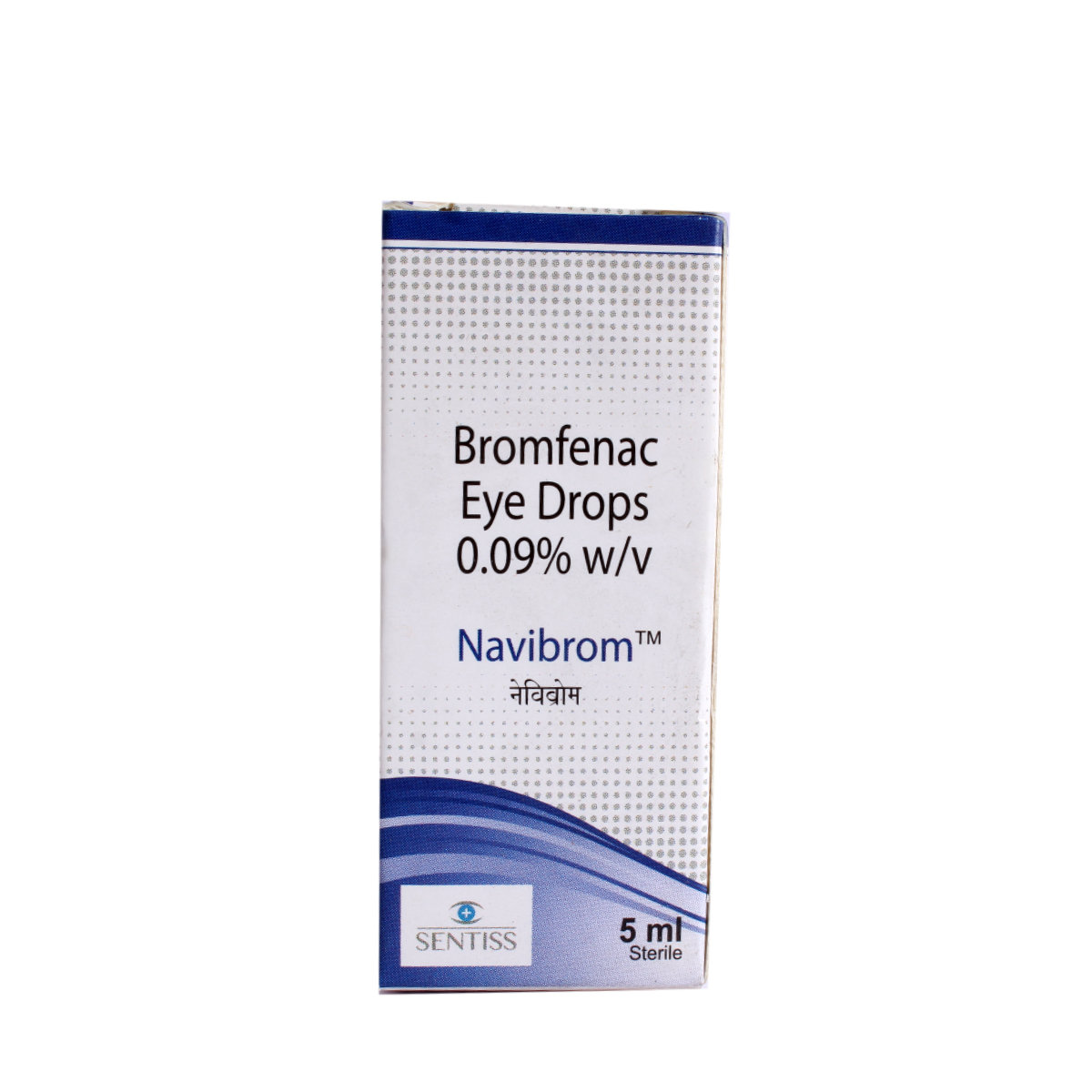Fenbro 0.09%W/V Eye Drops 5ml

MRP ₹120
(Inclusive of all Taxes)
₹18.0 Cashback (15%)
know your delivery time
Provide Delivery Location
Composition :
Manufacturer/Marketer :
Consume Type :
Expires on or after :
Return Policy :

Secure Payment

Trusted by 8 Crore Indians

Genuine Products
Therapeutic Class
Country of origin
Manufacturer/Marketer address
Author Details
We provide you with authentic, trustworthy and relevant information
Disclaimer
Alcohol
Safe if prescribed
The interaction of alcohol with Fenbro 0.09%W/V Eye Drops 5ml is unknown. Please consult a doctor before consuming alcohol with Fenbro 0.09%W/V Eye Drops 5ml.
Pregnancy
Consult your doctor
Fenbro 0.09%W/V Eye Drops 5ml is a Category C pregnancy drug, so it is not recommended for use during pregnancy in the last 3 months as it may cause harm to the unborn baby. Please consult a doctor if you are pregnant so that Fenbro 0.09%W/V Eye Drops 5ml is prescribed only if the doctor thinks benefits outweigh risks.
Breast Feeding
Consult your doctor
Fenbro 0.09%W/V Eye Drops 5ml may be safe to use in breastfeeding mothers if it is prescribed by a doctor.
Driving
Safe if prescribed
Fenbro 0.09%W/V Eye Drops 5ml may cause blurred vision for a short time immediately after using Fenbro 0.09%W/V Eye Drops 5ml. So, drive only when your vision is clear after taking Fenbro 0.09%W/V Eye Drops 5ml.
Liver
Consult your doctor
If you have any concerns regarding the use of Fenbro 0.09%W/V Eye Drops 5ml in patients with liver problems, please consult a doctor.
Kidney
Consult your doctor
If you have any concerns regarding the use of Fenbro 0.09%W/V Eye Drops 5ml in patients with kidney problems, please consult a doctor.
Children
Safe if prescribed
Fenbro 0.09%W/V Eye Drops 5ml is not recommended for children as the safety and effectiveness were not established.
Product Substitutes
About Fenbro 0.09%W/V Eye Drops 5ml
Fenbro 0.09%W/V Eye Drops 5ml belongs to a class of pain killers called non-steroidal anti-inflammatory drugs used to reduce eye inflammation after cataract surgery in adults. Eye inflammation after cataract surgery is a common condition in which eyes become swollen and red.
Fenbro 0.09%W/V Eye Drops 5ml contains Bromfenac which works by inhibiting the release of certain natural substances such as prostaglandins in the eye that cause pain and swelling. Thereby, helps in relieving eye pain and swelling after cataract surgery.
Use Fenbro 0.09%W/V Eye Drops 5ml as prescribed. Fenbro 0.09%W/V Eye Drops 5ml is only for use in the eyes. Do not swallow or inject Fenbro 0.09%W/V Eye Drops 5ml. Your doctor will advise you on how many drops to instill based on your medical condition. In some cases, you may experience mild eye irritation, headache, seeing floaters or flashes of light before the eyes, or increased sensitivity of the eyes to light. Most of these side effects of Fenbro 0.09%W/V Eye Drops 5ml do not require medical attention and gradually resolve over time. However, if the side effects worsen or persist, please consult your doctor.
If you are allergic to Fenbro 0.09%W/V Eye Drops 5ml or any other medicines, please tell your doctor. Fenbro 0.09%W/V Eye Drops 5ml is not recommended for children. You are not advised to use Fenbro 0.09%W/V Eye Drops 5ml if you are pregnant, especially in the last 3 months of pregnancy as it may harm the unborn baby. You are advised to remove soft contact lenses before using Fenbro 0.09%W/V Eye Drops 5ml as it may cause discoloration of the soft contact lens. You are advised to maintain a 5 minutes time gap between using Fenbro 0.09%W/V Eye Drops 5ml and other eye drops. Please do not touch the container's tip to the eye, eyelids, or surrounding areas as it may contaminate Fenbro 0.09%W/V Eye Drops 5ml and cause eye infections. If you have diabetes, rheumatoid arthritis, bleeding problems, dry eyes, or cornea problems, before taking Fenbro 0.09%W/V Eye Drops 5ml.
Uses of Fenbro 0.09%W/V Eye Drops 5ml
Medicinal Benefits Mweb
Key Benefits
Fenbro 0.09%W/V Eye Drops 5ml contains Bromfenac, a non-steroidal anti-inflammatory drug (pain reliever) used to reduce eye inflammation after cataract surgery in adults. Fenbro 0.09%W/V Eye Drops 5ml works by inhibiting the release of certain natural substances such as prostaglandins in the eye that cause pain and swelling. Thereby, helps in relieving eye pain and swelling after cataract surgery.
Directions for Use
Side Effects of Fenbro 0.09%W/V Eye Drops 5ml
- Mild eye irritation
- Headache
- Seeing floaters or flashes of light before the eyes
- Increased sensitivity of eyes to light
Drug Warnings
If you are allergic to Fenbro 0.09%W/V Eye Drops 5ml or any other medicines, please tell your doctor. Fenbro 0.09%W/V Eye Drops 5ml is not recommended for children. You are not advised to use Fenbro 0.09%W/V Eye Drops 5ml if you are pregnant, especially in the last 3 months of pregnancy as it may harm an unborn baby. You are advised to remove soft contact lenses before using Fenbro 0.09%W/V Eye Drops 5ml as it may cause discoloration of the soft contact lens. You are advised to maintain a 5 minutes time gap between using Fenbro 0.09%W/V Eye Drops 5ml and other eye drops. Please do not touch the container tip to the eye, eyelids, or surrounding areas as it may contaminate Fenbro 0.09%W/V Eye Drops 5ml and cause eye infections. If you have diabetes, rheumatoid arthritis, bleeding problems, dry eyes, or cornea problems, contact the doctor before taking Fenbro 0.09%W/V Eye Drops 5ml.
Drug-Drug Interactions
Drug-Drug Interactions
Login/Sign Up
using Fenbro 0.09%W/V Eye Drops 5ml and ibuprofen can increase the risk of side effects in the gastrointestinal tract such as inflammation, bleeding, ulceration, and rarely, perforation.
How to manage the interaction:
Taking Fenbro 0.09%W/V Eye Drops 5ml and ibuprofen can lead to an interaction, it can be taken if advised by your doctor. However, if you experience any symptoms like unusual bleeding or bruising, dizziness,ightheadedness,red or black, tarry stools,coughing up or vomiting fresh or dried blood that looks like coffee grounds,severe headache,and weakness, consult the doctor immediately. Do not stop using any medications without a doctor's advice.
Taking Diclofenac with Fenbro 0.09%W/V Eye Drops 5ml will have an additive effect and may increase the risk of side effects in the gastrointestinal tract such as inflammation, bleeding, ulceration, and rarely, perforation.
How to manage the interaction:
There may be possible interaction between diclofenac and Fenbro 0.09%W/V Eye Drops 5ml but you can take it if prescribed by a doctor. Consult your doctor if you experience any unusual bleeding or bruising or have other signs and symptoms of bleeding such as dizziness; lightheadedness; red or black, tarry stools; coughing up or vomiting fresh or dried blood that looks like coffee grounds; severe headache; and weakness. Do not stop using any medications without first talking to your doctor.
Coadministration of Apixaban with Fenbro 0.09%W/V Eye Drops 5ml may increase the risk or severity of bleeding which can lead to severe blood loss.
How to manage the interaction:
Although there is a possible interaction between Apixaban with Fenbro 0.09%W/V Eye Drops 5ml, it can be taken if prescribed by your doctor. However, if you notice any unusual bleeding or bruising, or other signs and symptoms of bleeding, such as dizziness, lightheadedness, red or black, tarry stools, coughing up or vomiting fresh or dried blood that looks like coffee grounds, severe headache, and weakness, you should seek immediate medical attention. Do not stop using any medications without first talking to your doctor.
Drug-Food Interactions
Drug-Food Interactions
Login/Sign Up
Drug-Diseases Interactions
Drug-Diseases Interactions
Login/Sign Up
Habit Forming
Special Advise
- Avoid wearing contact lenses while using Fenbro 0.09%W/V Eye Drops 5ml as it may cause discoloration of soft contact lenses.
- Don't rub your eyes for at least 1 month after cataract surgery.
- Don't use tap water for washing eyes for at least 1 week after cataract surgery.
- Wear sunglasses for bright light for at least 1 year.
- If you have signs of vision loss, pain in the eye even after using painkillers, light flashes in front of your eyes, nausea, vomiting, or excessive coughing immediately contact your eye surgeon.
Diet & Lifestyle Advise
- Eat Omega-3 fatty acids-rich foods such as sardines, mackerel, tuna, salmon, trout, and omega-3 fatty acid supplements.
- Cut down your coffee intake as it may increase pressure in the eye and replace coffee with green tea.
- Maintain a diet rich in antioxidants such as dark-green leafy vegetables, whole grains, citrus fruits, broccoli, Brussels sprouts, etc.
- Avoid consumption of processed foods such as high-fat meats, sugary foods, dairy products, and fast foods as they may increase inflammation.
All Substitutes & Brand Comparisons
RX
Out of StockADBROM EYE DROPS 5ML
Akumentis Healthcare Ltd
₹150.5
(₹27.09/ 1ml)
25% COSTLIERRX
Navibrom Eye Drops 5 ml
Sentiss Pharma Pvt Ltd
₹161
(₹28.98/ 1ml)
34% COSTLIER

Have a query?




